Initially this guide displays common birds of all types that are flying right now in our area. Use the selectors below to view rare birds, view birds flying any time, restrict the output to a certain shape of bird, or search by name.
New Mexico is on the western edge of the Central Flyway which is one of the major migration pathways between north and south for birds traveling between breeding and wintering grounds along the Rocky Mountains. This has resulted in the state having an incredible diversity of birds with over 550 different species reported. A little more than half of this number are sighted annually on the Pajarito Plateau. Some of these birds are full-time residents, some migrate here for a few weeks or months, and other are only seen briefly as they pass through the region.
This guide features many of the birds known to frequent Los Alamos county by when they are likely to be seen in the area. You can get additional information on local birds by joining PEEC Birders or going to the eBird website. eBird also includes lists of rare bird sightings and birding hot spots.
Bird References
Birdweb
Cornell Lab of Ornithology
eBird
eNature
Institute for Bird Populations
National Audubon Society
New Mexico Ornithology Society
What Bird
xeno-canto
Subject Area Experts (all guides)
Steve Cary (butterflies)
Beth Cortright (insects)
Terry Foxx (invasive plants)
Leslie Hansen (mammals)
Richard Hansen (fish, mammals)
Dorothy Hoard (butterflies, trees)
Chick Keller (flowers, herbarium)
Shari Kelley (geology)
Kirt Kempter (geology)
Garth Tietjen (reptiles)
David Yeamans (birds)
Web Development and Content Management
Pat Bacha
Jennifer Macke
Graham Mark
Akkana Peck
Contact
Please contact us for local nature questions and sightings. We welcome comments, corrections, and additions to our guides.
For more information about local nature, please visit our Nature Blog or subscribe to PEEC This Week.
Make Selection
 Photo: adult by Selvi Viswanathan  Photo: adult by Bob Walker  Photo: adult at nest in the vertical iron pipe by JN Stuart |  Ash-throated Flycatcher, Lower California FlycatcherATFL (Myiarchus cinerascens)Family: Tyrannidae (Tyrant Flycatchers) Size: 8 in (20 cm) Flies: Apr 01 - Aug 21 Morphology: males and females look similar; grayish brown overall, yellow belly, a white throat, two white wingbars, and cinnamon streaks on the primary feathers and underside of tail Status: native; locally common Food source: mostly insects including caterpillars, beetles, grasshoppers, and flies; also eats some spiders, fruits, and berries Habitat: deserts with cactus and mesquite thickets, dry woods, semi-arid country, canyon areas Ash-throated Flycatchers are spread throughout the west, preferring arid areas. These birds seldom forage by taking insects mid-air. Rather they fly out from a perch and pick insects from foliage while hovering. Alternatively, they will perch in shrubs or cacti to feed on fruit. Flycatchers primarily build nests in holes in trees, most often natural cavities or old woodpecker holes. However, given that the trees in their preferred nesting area may be small, they will use other hollow places like pipes and posts. The nest consists of a mass of weeds and grass lined with soft material. Females incubate the eggs for about 15 days. The young fledge at about 2 weeks of age. There are often 2 broods per year. Info Photos Distribution Frequency |
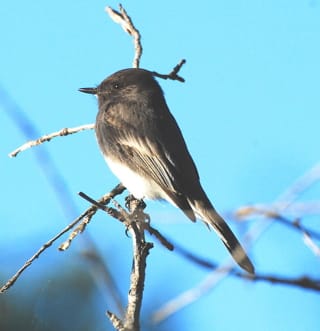 Photo: adult by Jerry Oldenettel 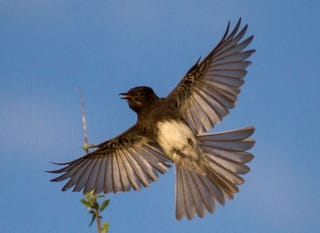 Photo: adult by Mouser Williams 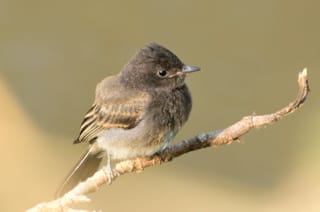 Photo: immature by Ricardo A. T. |  Black Phoebe, Black FlycatcherBLPH (Sayornis nigricans)Family: Tyrannidae (Tyrant Flycatchers) Size: 6 - 7 in (15 - 18 cm) Flies: Feb 15 - Sep 21 Morphology: adults are mostly dark gray on the upperparts with a gray chest, white belly, and black head that may show a slight peak on the crown; immatures are similar but with buffy-colored wingbars Status: native; locally common Food source: wide variety of insects including beetles, grasshoppers, crickets, bees, wasps, and caterpillars; occasionally will eat small fish Habitat: shady areas in open woods near water Typical location: Rio Grande Black Phoebes can often be seen on a perch low over water, wagging their tails up and down. Once an insect is sighted, the bird will dart out to catch its prey mid-air or even to pluck it off the water surface. Phoebes will also hover while picking insects from foliage. They are territorial and often maintain an established territory year-round. A male will perform a song-flight display during courting and show the female a potential nesting site. The female will then build a nest made of mud, plastered to a protected spot such a cliff face, bridge support, or building wall. Young usually leave the nest at 2 to 3 weeks of age. There are typically 2 broods per year. Info Photos Distribution Frequency |
 Photo: adult by Jerry Oldenettel  Photo: adult by Joe Zarki |  Cassin's KingbirdCAKI (Tyrannus vociferans)Family: Tyrannidae (Tyrant Flycatchers) Size: 8 - 9 in (20 - 23 cm) Flies: Apr 01 - Sep 07 Morphology: adults have dark grey faces with a white mustache and are gray on the head and chest, yellow on the belly and under the tail, and white on the tips of a dark tail Status: native; locally common Food source: eats a wide variety of insects along with some berries and fruits Habitat: savannas, rangelands, pinyon-juniper woodlands Typical location: Bandelier Entrance Road, Lower Ancho Canyon The Cassin’s Kingbird is similar to the Western Kingbird but with darker plumage. In addition, in comparison to Westerns, they are generally found higher in the trees and are usually quieter. These birds tend to sit on a perch looking for insects, and then fly out to capture it mid-air. Alternatively, they will pick off insects from leaves or from the ground. Courtship includes a fast, zigzag dance with outstretched wings and high-pitched calls. This dance is performed several times over a number of days. Nests are located high up in a deciduous tree or pine and have a bulky cup shape. Adults will harass larger birds that come too close. Info Photos Range Frequency |
 Photo: adult by Mitch Chapman  Photo: adult by Jerry Oldenettel |  Cordilleran FlycatcherCOFL (Empidonax occidentalis)Family: Tyrannidae (Tyrant Flycatchers) Size: 5.5 - 6 in (14 - 15 cm) Flies: Apr 21 - Sep 21 Morphology: adults are olive above and yellowish below with two pale yellow wingbars and teardrop-shaped eyerings; immatures are similar to adults but with buffy-colored wingbars Status: native; locally common Food source: mostly insects and spiders Habitat: mountain forests, wooded canyons Cordilleran Flycaters usually forage high up among the braches of tall conifers but may perch lower in trees along streams. They will watch for insects and then fly out to catch them mid-air. However, they will also glean some prey directly from the foliage of trees and shrubs. Nest sites vary from the fork of small tree to a cleft in a vertical stream bank to a under a fallen tree. Nests may even be found in or under man-made structures. Nests are cup-shaped and made of moss, grass, and other plant fibers lined with hair and feathers. First flight occurs at about 2 weeks of age. Info Photos Distribution Frequency |
 Photo: adult by Dave Yeamans  Photo: adult by Jon McIntyre  Photo: adult on nest by Roy Pilcher |  Dusky FlycatcherDUFL (Empidonax oberholseri, Empidonax obscurus)Family: Tyrannidae (Tyrant Flycatchers) Size: 5.3 - 6 in (13 - 15 cm) Flies: Apr 15 - Sep 15 Morphology: both sexes are gray overall with lighter underparts, a yellowish wash across the chest, white eyerings, light-colored wingbars, and a slightly rounded crest that is not always visible; immatures are like adults but with broader wingbars and more yellow on the lower mandible Status: native; locally common Food source: small insects Habitat: woodlands, mountain chaparral, open forests Dusky Flycatchers are intermediate in size and shape between Hammond’s and Gray Flycatchers. They also prefer the middle elevations in the mountains. Dusky Flycatchers forage by perching in an exposed area and watching for prey. Insects are usually captured in the air but may be taken from on the ground or from off of foliage. These birds are often seen in pinyon-juniper forests but prefer to nest in mixed conifer. During courtship both members of a pair with hop around, fluttering wings. Nests are usually built in deciduous shrubs in a vertical fork among dense foliage. Young leave the nest at about 2 to 3 weeks if age. Info Photos Distribution Frequency |
 Photo: adult by Marion L. Stelts  Photo: adult by Bob Walker |  Gray Flycatcher, Wright's FlycatcherGRFL (Empidonax wrightii, Empidonax canescens)Family: Tyrannidae (Tyrant Flycatchers) Size: 5.5 in (14 cm) Flies: Apr 01 - Sep 21 Morphology: adults have gray back, white belly, thin eyering. pale wingbars, and pale mark in front of the eye; immature similar to adult but with brownish upperparts, buff underparts, and buff wingbars Status: native; locally common Food source: only insects Habitat: sagebrush, pinyon-juniper woodlands Gray Flycatchers, which are very similar to Dusky Flycatchers, seldom sit still for long. They slowly lower and raise their tails when perched. These birds watch for insects from an exposed perch and then fly out to catch them, either on the ground or in mid-air. Gray Flycatchers winter farther north than other species in the same genus. They can commonly be seen in southern Arizona during the winter months. They typically build nests in inconspicuous areas in the crook of a bush or tree and sometimes nest in a loose colonies. The young fledge at a little over 2 weeks of age. Info Photos Distribution Frequency |
 Photo: adult by Daniel Sheron  Photo: adult by Jerry Oldenettel |  Hammond's FlycatcherHAFL (Empidonax hammondii)Family: Tyrannidae (Tyrant Flycatchers) Size: 5 - 5.5 in (13 - 14 cm) Flies: Apr 21 - Sep 01 Morphology: adults are primarily gray overall with prominent white eyering and wingbars; immatures are similar to the adults but with broader, more buff wingbarsadults are primarily gray overall with prominent white eyering and wingbars; immatures are similar to the adults but with broader, more buff wingbars Status: native; locally common Food source: feeds only on insects Habitat: mature coniferous forests at high altitudes Hammond’s Flycatchers are very similar to Dusky Flycatchers but seem to prefer cooler habitats and nesting sites higher in the mountains and farther north. Hammond’s Flycatchers constantly move while perched, flicking wings and cocking their tails at same time. They carefully watch from a perch, and then fly out to catch their prey or pick it directly off of the surface of foliage or branches. A male will vigorously defend a territory during breeding season and may actually fight other males. Nests are usually located on a horizontal branch and consist of a cup made of stems, bark, lichens and other materials like feathers and spiderwebs. Young fledge at about 2 1/2 weeks old but tend to stay with their parents for another week or two. Info Photos Range Frequency |
 Photo: adult by Bob Walker  Photo: adult by Jerry Oldenettel  Photo: adult by Greg Lasley |  Olive-sided FlycatcherOSFL (Contopus cooperi )Family: Tyrannidae (Tyrant Flycatchers) Size: 7.5 - 7.5 in (19 - 19 cm) Flies: Apr 21 - Sep 21 Morphology: both sexes are stocky with large heads and short tails and are olive-gray on the top fading to lighter gray on the sides, there is a distinctive white center on the breast that gives the appearance of a vest; immatures similar to adults but browner Status: native; uncommon Food source: feeds almost entirely on flying insects Habitat: spruce and fir forests, usually near openings and ponds Olive-sided Flycatchers have become less common in recent years, potentially due to loss of wintering habitat. They are most often observed sitting upright on a high perch such as the top branch of a tree or on a power line. These birds forage by watching on high, flying out to catch a passing insect, and then returning to their perch. Males defend a nesting territory by singing constantly in the spring. Nests are usually well hidden on a horizontal branch of a conifer. First flight for the young is at about 3 weeks of age. Info Photos Distribution Frequency |
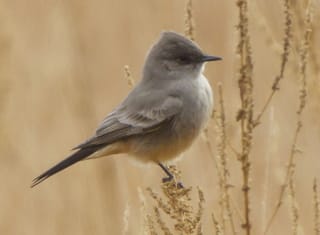 Photo: adult by Mouser Williams  Photo: adult by Bob Walker 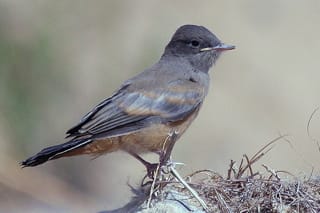 Photo: immature by J.N. Stuart |  Say's PhoebeSAPH (Sayornis saya)Family: Tyrannidae (Tyrant Flycatchers) Size: 7 - 8 in (18 - 20 cm) Flies: Feb 15 - Nov 15 Morphology: adults are brownish gray above with a reddish-brown belly, blackish tail, a gray breast, a head feathers that is sometimes raised into a small peak; immatures are similar to adults but browner and may have a buffy wing bar Status: native; locally common Food source: feeds almost entirely on insects with some spiders and millipedes Habitat: dry sunny areas, often near buildings The Say’s Phoebe is most often seen prominently perched in low shrubs or on rocks. They typically catch insects by darting out and grabbing them in mid-air, picking them off of foliage, or scooping them up from the ground. They can also hover low over fields trying to spot prey. Like other phoebes, Say’s Phoebes have a habit of wagging their tails but, unlike other phoebes, they often live in very dry areas. Males defend a nesting territory by singing. Nests are cup-shaped and made of grass, weeds, and other materials but no mud like other phoebes. Placement of a nest can vary from on a rocky cliff to a man-made structure. Young leave the nest in about 2 weeks after hatching. There are typically 1 to 2 broods per year. Info Photos Range Frequency |
 Photo: adult by Jerry Oldenettel  Photo: adult by Bob Walker |  Western Kingbird, Arkansas FlycatcherWEKI (Tyrannus verticalis)Family: Tyrannidae (Tyrant Flycatchers) Size: 8 - 9 in (20 - 23 cm) Flies: Apr 21 - Sep 21 Morphology: gray-headed birds with straight bills, brown wings, yellow belly, white chest and throat, and black tails with white outer feathers Status: native; uncommon Food source: eats mostly insects but also spiders, millipedes, and some berries and fruits Habitat: open country, ranches, roadsides, waterways with trees Western Kingbirds are most often seen in open areas on prominent perches. They will fly out and snatch up an insect either in mid-air or from off the ground and then return to the same perch. They will also pursue flying insects for long distances. Males have an elaborate courtship display, soaring to about 60 feet (18 meters) in the air and then stopping abruptly and falling towards the ground. These birds have adapted well to civilization and will even build nests attached to utility poles near busy city streets. Western Kingbirds are very feisty and protect their nests by harassing much larger birds that come too close. The eggs are incubated for a little over 2 weeks. The young leave the nest approximately 3 weeks later. Info Photos Distribution Frequency |
 Photo: adult by J.N. Stuart  Photo: adult by J.N. Stuart  Photo: chicks in nest by Jerry Oldenettel |  Western Wood-PeweeWEWP (Contopus sordidulus, Contopus richardsonii)Family: Tyrannidae (Tyrant Flycatchers) Size: 6.5 - 6.5 in (17 - 17 cm) Flies: Apr 15 - Sep 21 Morphology: medium-sized bird with a peaked crown that makes the head appear triangular; adults are grayish brown with a dark face, dark bill with some yellow at the base, pale wingbars, whitish underparts, and a bit of gray on the breast and sides; immatures are similar to adults but with buffy wingbar Status: native; common Food source: mostly flying insects: flies, wasps, bees, winged ants, and moths; occasionally eats a few berries Habitat: open woodland, woodland edges The Western Wood-Pewee is a flycatcher that is best known for its rough sounding whistle. It is very similar to the Eastern Wood-Pewee, but the two are considered to be different species. Western Wood-Pewees most often watch for an insect from an exposed tree perch and then make an aerial sortie to catch it, sometimes making a clacking noise with their bill. They will also take insects from foliage and tall grasses. Males typically sing at dawn and duck to defend a territory. Females build a flat, open nest in a tree that may look like a knot on a branch from below. Young take their first flight at about a little over 2 weeks after hatching. Info Photos Distribution Frequency |
